The Wisdom & Market Efficiency of Pinnacle.com compared to other Bookmakers
Posted 24th February 2017
Those who are familiar with my articles will know I've talked quite a lot about how efficient published betting odds prove to be, that is to say how accurately betting odds reflect actual outcome probabilities. In August 2015 I published some material on the wisdom of the (betting) crowd that was taken from my latest book Squares & Sharps, Suckers & Sharks: The Science, Psychology & Philosophy of Gambling. This reviewed a methodology for using the lines from Pinnacle.com's football match betting market (1X2) as a benchmark for accurate betting odds. Pinnacle are well known in the industry for having the most efficient (accurate) betting odds. It is precisely for this reason that they are able to offer the shortest margins and accept winners without question. With Pinnacle's betting margin removed from their odds (via a model described in the original article and in my book), the method assumes that wherever you find another price with another bookmaker that is superior, this should theoretically offer you some positive expectation, in other words a value bet.
For this article I wanted to go back and review this methodology with a now larger sample of matches compared to the original analysis of 22,318 domestic European league games. Furthermore, I wanted to look in more detail at just how accurate a guide Pinnacle's betting odds are at determining value available with other bookmakers. Finally, I wanted to see if other bookmakers are as efficient as Pinnacle and whether they, too, could be used as value guides in a similar way.
As for the original analysis, betting odds come from those I collect on a regular basis for Football-Data, from 22 domestic European divisions during the period 28th July 2012 to 20th February 2017. The odds are generally neither opening nor closing, but represent a snapshot in time at the moment I collect them. Consequently we can be confident that that the prices at different bookmakers were those available at the same time. I chose to compare Pinnacle with 4 leading UK bookmakers: bet365, Ladbrokes, William Hill and Betvictor. Having removed all matches with missing odds and those where errors were obvious left a sample size of 35,570 matches and 106,710 individual home/draw/away betting odds.
The next step is to remove the betting margin from the odds for each bookmaker. To do this I take into account the disproportional weighting bookmakers will apply to their odds depending on how long or short they are (more weight for longer odds), due to the influence of the favourite-longshot bias. Without going over the original explanations, I use the following formula to back-calculate the fair odds from the published one.
Of = 3O/(3-MO)
where:
M (the overall book margin) = [(1/H)+(1/D)+(1/A)] - 1
For a more detailed explanation of this method, see the original Wisdom of Crowds article, or better still buy my book. I'm aware that this methodology will not be the one used by bookmakers to apply their margin, but for a wide range of odds it would appear to represent a reasonable approximation for most of the bookmakers.
Finally, we can calculate a ratio of the actual betting odds from a bookmaker to the fair odds for any other bookmaker. For this exercise I have:
- Calculated the ratio of the actual odds from the 4 UK bookmakers to the fair Pinnacle odds
- Calculated the ratio of the actual Pinnacle odds to the fair odds for the 4 UK bookmakers.
The hypothesis here is that the value of the ratio should provide an indicator of the profit expectation or expected value. For example, if our calculated fair odds are 2.00 and another bookmaker offers odds of 2.10, the expected value will be given by 2.10/2.00 = 1.05 or 5%. That is to say, betting such propositions over the long term should return us a 5% profit over turnover, or a 105% return on investment (stakes).
Under investigation here is how valid is such a hypothesis, and for which bookmakers. Validity will depend on how accurate or efficient a bookmaker's betting odds really are. Using them as a guide to finding value will only work if those odds offer an accurate reflection of the underlying match probabilities. Let's first look at the efficiency of Pinnacle.com.
The following scatter plot shows pairs of expected returns (as measured by the ratio of the actual odds at bet365, Ladbrokes, William Hill or Betvictor to the fair odds as assumed by Pinnacle) versus actual returns (to level stakes) from bet365, Ladbrokes, William Hill or Betvictor. Actual returns were calculated at 0.01 odds intervals of the expected return. A 5-point running average was then used to smooth the variance in the data. So for example the actual return for the point at 0.95 on the expected return axis is in fact the average of the actual returns for 0.93 through to 0.97 on the expected return axis. With such a large dataset many of these pairs are based on tens of thousands of odds, and can thus be considered statistically reliable. Naturally at the extremities of the expected returns (less than 0.8 and more than 1.1) the number of included odds diminishes substantially and variance in actual returns increases dramatically. I have restricted the range to that shown for visual clarity and to emphasise the conclusion that we can draw from this analysis.
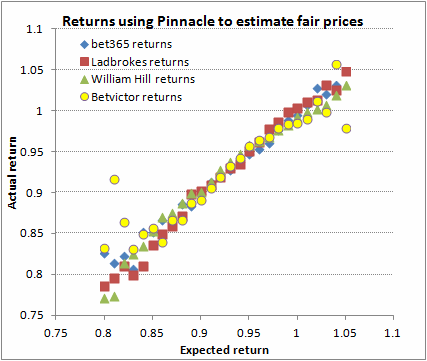
The result is striking. Clearly Pinnacle provides an excellent means of identifying the true price of an outcome, and thereby identify not only where value exists but quantifying it exactly. The correlation between expected and actual returns is close to a perfect 1:1 relationship. Thus, where expected return is 0.9, we see about 0.9 for our actual return; where expected is 0.95, actual is 0.95; and so on. Although I've not shown them, the trend line gradients for all 4 bookmakers are essentially 1, and the statistical strength of the correlations (as measured by R-squared) is high.
Armed with this knowledge, we can now use it to find positive expectation. Naturally, the number of odds where expected value is greater than 1.00 is limited (in fact in this sample of 106,710 odds there were 24,150 occasions across all 4 UK bookmakers). The average expected value of these odds was 1.016, close to the actual return of 1.018 (or 101.8%). The breakdown by different bookmaker is shown in the table.
| Bookmaker | Bets | Expected Return | Actual Return |
| bet365 | 6250 | 101.67% | 103.30% |
| Ladbrokes | 3935 | 101.81% | 102.64% |
| William Hill | 7669 | 101.54% | 101.20% |
| Betvictor | 6296 | 101.45% | 100.53% |
| All | 24150 | 101.60% | 101.81% |
You can see that returns from bet365 were a little luckier than expected, returns from Betvictor a little unluckier. Raising the threshold of minimum acceptable value improves returns, although at the expense of available opportunities. As this number falls we can expect a greater variance between actual and expected returns, with an increasing influence due to luck. Fortunately as the next table illustrates, in this sample luck has been on our side with actual returns outstripping expected ones consistently as the threshold rises. Readers should not be lulled into a false sense of security by this. Just as likely is an underperformance relative to expectation, and followers of this methodology should run a full Monte Carlo analysis to determine the range of possible outcomes.
| Value Threshold | Bets | Expected Return | Actual Return |
| 1.01 | 12689 | 102.62% | 102.75% |
| 1.02 | 6357 | 103.69% | 103.80% |
| 1.03 | 3209 | 105.14% | 107.43% |
| 1.04 | 1733 | 106.59% | 115.65% |
| 1.05 | 1024 | 108.08% | 119.46% |
| 1.06 | 624 | 109.75% | 119.27% |
Of course, I've been posting 'Wisdom of the Crowd' value like this on the Football-Data website since August 2015 with encouraging results just like these.
Now let's investigate how we might have performed betting Pinnacle's odds whilst using the 4 UK bookmakers as a measure of expectation. This time, instead of using Pinnacle's betting prices to estimate 'true' outcome probabilities, we are using those from bet365, Ladbrokes, William Hill and Betvictor. Again, actual returns (again to level stakes) from betting Pinnacle's odds are plotted against each 0.01 expected returns increment using a 5-point running average.
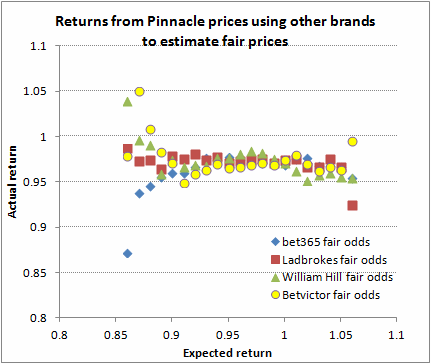
Notice anything different? Well, that's an understatement to say the least. This time there is essentially no meaningful correlation between expected return (as predicted by the fair prices of the 4 UK bookmakers) and actual return betting Pinnacle's odds. Regardless of whether Pinnacle's odds are shorter or longer than the calculated fair prices, it seems your return will basically be the same: a loss roughly equivalent to Pinnacle's margin.
The conclusion here has to be this: relative to Pinnacle's 1X2 betting market, the 4 UK brands analysed here are not efficient and do not provide an accurate measure of 'true' outcome probabilities. So for example, when Ladbrokes offers a price of 2.00 implying a fair price of 2.13 whilst Pinnacle decide to offer 2.20, this will not mean that the punter holds an expectation of 1.033 (or 2.20/2.13). Rather, it will mean that the implied true odds are something like 2.25 and you can expect to make a loss over the long term betting these propositions with Pinnacle.
There are two possible explanations to account for these results. The first is that my model for calculating fair prices lacks reliability, and the greater the margin applied by the bookmaker, the greater the inaccuracy. Pinnacle, of course, have the smallest margins. The average in this sample of matches was 2.7%. This compares to 4.1%, 5.5%, 7.4% and 7.8% for Betvictor, bet365, William Hill and Ladbrokes respectively. It is possible that my model for estimating fair prices just doesn't work well when margins are larger and when books have heavy favourites and large underdogs. However, given that level stakes returns blind betting all 106,710 selections are 99.88%, 100.13%, 99.80%, 99.59% and 100.00% for Pinnacle, bet365, Ladbrokes, William Hill and Betvictor respectively, the model must be doing something right. Furthermore, I have tested the correlation between expected and actual returns without removing the margin at all and broadly the same patterns exist. Finally, arbitrage punters who use Pinnacle are probably familiar with the reality that it's typically the other bookmaker that sits on the profitable side of the arb. It's obviously no surprise, then, that Pinnacle are the only bookmaker to openly welcome arbitrage bettors, knowing that, unlike the other brands, they are not offering postive expectation by doing so. Consequently, I think it's safe to argue that any inaccuracy that may exist in the way I remove the bookmaker's margin to estimate fair prices is having little or no influence on these findings.
The other explanation for such a state of affairs is that relative to Pinnacle, the UK brands are to some extent indulging in supply side price manipulation. Whilst Pinnacle adopts a laissez-faire approach to their market management, allowing the flow of money to dictate prices, other brands may well be intentionally offering attractive but inaccurate prices in an attempt to secure the attention of potential new customers as well as to sell the idea of offering better value than their rivals. So for example, Pinnacle offered a price of 1.22 for Barcelona to beat Espanyol on the 2nd January 2016 that was longer than Betvictor's implied fair price of 1.20. Yet, conceivably, Betvictor artificially shortened Barcelona's price relative to what they knew was fair with a view to going top market for Espanyol, at 19. This price, and not Pinnacle's price for Barcelona, would then represent the value, based on Pinnacle's implied fair odds of 16.8.
Whilst it is pure conjecture that brands manipulate their markets like this, the regular restriction and banning of customers who regularly exploit top market loss-leading value would be a pattern consistent with such a conclusion. If bookmakers know they are intentionally offering loss-leading value to customers it's not going to prove very cost effective for them if they allow those customers to continually exploit such value while the other parts of the book are attracting little or no custom at all. Of course, Pinnacle, with a much more passive price management system that reflects customer turnover will not suffer the same problem. The consequence is that Pinnacle, relative to other brands, will offer more efficient and accurate markets as a reflection of 'true' outcome probabilities.
This is not to say that other brands' markets are completely inefficient. Rather, this analysis is simply illustrating that Pinnacle is more efficient than the rest. We can also compare the UK brands with each other, to establish some sort of efficiency hierarchy. The following 4 plots of actual returns against expectation reveal that Betvictor and bet365 are more efficient than Ladbrokes and William Hill.
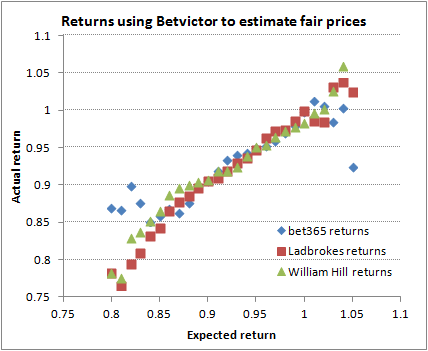
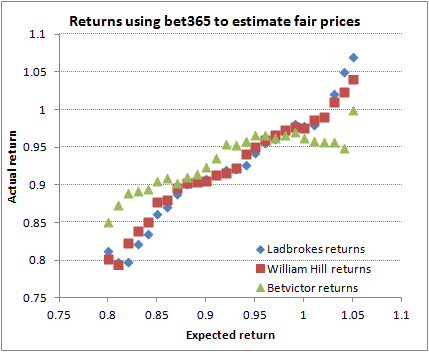
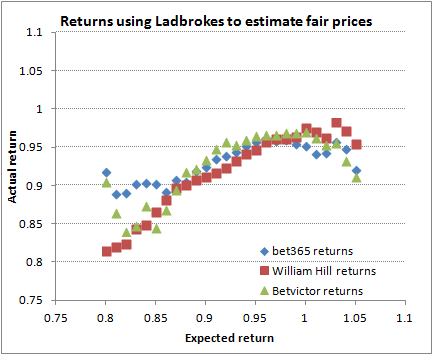
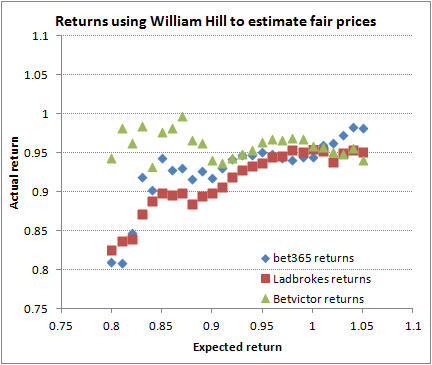
Regardless of the explanation, it is clear that using odds from Ladbrokes and William Hill to estimate 'true' outcome probabilities with this model is basically worthless, given that we cannot find consistent positive value at Betvictor or bet365. On the other hand, Betvictor and bet365 offer some means of finding positive expectation at Ladbrokes and William Hill. However, when Pinnacle is so far ahead of both, it rather begs the question: why bother? We might as well use Pinnacle as a measure for estimating fair prices full stop.
This analysis set out to test the efficiency of Pinnacle.com relative to other online sport books. It has again conclusively shown that Pinnacle betting odds for the football match betting market (1X2) offer a very reliable measure of the 'true' outcome probabilities for those matches once their margin has been removed, which can then be use to identify potential value opportunities at less efficient bookmakers.
|





